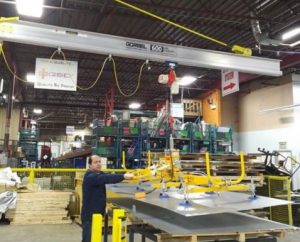 What you need to know to properly size a vacuum lifter
What you need to know to properly size a vacuum lifter
May 9, 2016 REDWIRE is news you can use from leading suppliers. Powered by FRASERS.
Posted by Engineered Lifting Systems & Equipment Inc.
With over 40 years of experience, Engineered Lifting Systems & Equipment Inc. provides standard & custom overhea... Read more
Subscribe
Free REDWIRE e-newsletter

Engineered Lifting Systems & Equipment (ELS) prides itself on offering a wide selection of standard and custom overhead material lifting systems. Its comprehensive portfolio includes vacuum lifters, which the company can size to meet the needs of each specific application.
The key details needed
In order for ELS to size a vacuum lifter, particular variables need to be confirmed. For example, if a vacuum lifter is needed to handle sheet metal, the following information is required:
- Maximum sheet size: What is the maximum length, width and thickness of the sheets the lifter will be handling? This helps determine the lifter’s overall capacity.
- Minimum sheet thickness: What is the minimum thickness of the sheet the lifter will be handling? This helps determine the number of vacuum cups required to reduce deflection. A two-inch deflection is the normal design maximum for sheet steel.
- Power sources: What power sources are available or desired? ELS typically suggests a self‐contained mechanical vacuum generator that requires no outside power source and can be lifted with any overhead crane/hoist or forklift.
- Sheet configuration: Are the sheets always lying flat or do they need to stand up?
- Sheet appearance: Are the sheets solid, or are there holes or cutouts in them?
- Work space: Are there existing overhead lifting devices that cover the work area? If there are not, careful consideration must be taken to ensure adequate floor coverage without creating interferences or blocking egress routes or light curtains.
- Other operations: Are there other operations in the work cell that would require the use of a lifting device? This would indicate whether the vacuum lifter would need to be quickly and easily swapped out with other equipment.
- Additional considerations: Two-speed hoists should be used whenever possible to prevent “jerking” the load. Any air resistance can pry the sheet metal off of the vacuum cups. Also, proper elevations are key to ensuring that the operator’s hands are in the optimal ergonomic working ranges.
A leading manufacturer
Engineered Lifting Systems & Equipment has been making difficult jobs seem easy for more than 45 years. With two manufacturing plants based in Elmira, Ont., the company is well positioned to meet its customers’ needs with its offering of standard and custom equipment.
Share
Posted by Engineered Lifting Systems & Equipment Inc.
With over 40 years of experience, Engineered Lifting Systems & Equipment Inc. provides standard & custom overhea... Read more